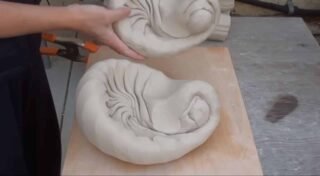Today we’re going to dive into the wonderful world of slab building in ceramics! Slab building is a versatile technique that opens up a world of possibilities for shaping clay into functional and artistic forms, and it’s a great way to break out of the round forms we so often find ourselves making on the wheel. Whether you’re a seasoned ceramic artist eager to expand your repertoire or a beginner excited to learn a new skill, this guide is here to equip you with 12 must-have tools that will take your slab building to the next level. From designing to rolling, and everything in between, these essential tools will become your trusted companions in your clay adventures.
Potter’s Knife

Slab work involves a lot of careful cutting, so a good potter’s knife is a must. Look for one that has a thinner blade and a fine point, as this will make cutting curves easier. You may find an X-acto knife is also handy with its interchangeable blades and smaller size.
Miter Cutter

utters_amps_Trimming_Tools/6309
This is a favorite tool for slab builders as it allows you to bevel the edge of your slabs. Beveled edges are desirable because they increase the surface area of the joined areas, making them stronger, and they also create a cleaner, sharper corner. Most miter cutters are designed with replaceable wire, and offer 2 angle options.
Plaster or Wooden Boards

Edge—12-5mm-x-1-2m-x-2-4m/p/104123
Absorbent boards are essential not just to work off of, but for helping to keep your slabs flat while they set. They are also great space savers, as they allow you to stack a number of slabs as you work. If using plaster boards, be sure to tape up any edges to prevent the plaster from chipping and contaminating your clay. If using wood, consider MDF, as its lack of grain makes it less prone to warping when wet.
Clay Compass

38020/circle-cutter-7/
An often overlooked tool, the clay compass is a great addition to any slab builder’s toolbox. Available in a variety of lengths, they use two pins (sometimes removable pin tools) to pivot from and mark out a perfect circle onto your slab. Some models include a marked ruler on the horizontal piece, making it easy to get circles of your desired diameter.
Set Square

010-dual-colour-quick-square-7/
Another overlooked tool, set squares are great for slab builders, particularly if you are looking for precisely measured lengths and square angles. We prefer the models with a base, as you can use it to butt against the bottom edge of your slab, giving you more confidence in the alignment and preventing it from sliding as you score or cut.
Board or Paper for Templates

-waxed-kraft-55gsm-100-metre-roll.html
While there are plenty of slab builders who like to work freeform, many of us prefer to work from templates. If you also fall into the latter category, then you need to find a versatile material to make them from, something that is strong, water resistant, and, in some cases, flexible. One of our favorites is waxed kraft paper or tar paper, as it ticks all of these boxes. You can also use craft foam, acrylic sheets (with a sanded surface to prevent sticking), wax paper, matte board, or thin plywood. Some materials will last longer than others, so play around and see what works best for you.
Dowels or Wooden Strips

If you are rolling your slabs by hand, then you’ll want something to help you measure and maintain an even thickness. Dowels and wooden strips are the perfect tools for the task. Have a selection of thickness in pairs on hand. As you roll, start with the thickest ones, working your way up to the thinnest. This will help you roll even slabs every time!
Rolling Pin

two-fixed-handled-rolling-pin-45cm
Along with those dowels, you’ll need a good rolling tool, which of course is the trusty kitchen rolling pin! If you are rolling out a lot of slabs, it’s worth investing in a well made model that has some weight. Also consider getting a model with fixed handles as these are stronger and less prone to breaking. If you’re up to some design fun with your rolling pins, you can also order laser-engraved versions that come with embossed designs, allowing you to easily create slabs with depth and pattern!
Tile Cutters

.uk/products/4-5-square-tile-cutter-115mm
Slab builds frequently find themselves drawn to tile making, and it’s easy to see why. They are functional, decorative, and full of creative potential! If you’re passionate about tile making and it’s a regular part of your clay repertoire, consider getting a tile cutter. They are a huge time saver, while also being designed to reduce warping with their spring-loaded release plates. Most designs are strongly made, and come in a variety of shapes so that you aren’t bound by the confines of the traditional square!
If you’ve been captivated by the world of tile making and are looking to explore different tile making techniques, we’ve got you covered! Our workshop with Paul Barchilon, ‘Geometric Tiles’, will have you creating beautiful press molded tiles with complete patterns in no time!
Press and hump molds

Moulds/m-789.aspx
Simple press and hump molds are a great way to make simple forms such as plates and bowls out of your slabs. Press molds are concave molds that you press the clay into, and hump molds (sometimes called drape molds) are convex molds that you lay the clay over. Which style of mold you use is generally a matter of preference, but sometimes the mold type does matter, such as with a deep bowl. In this example, a press mold will allow shrinkage in and away from the mold while a hump mold will cause the bowl to shrink inwards towards the mold, resulting in cracking. So some consideration is needed when deciding on which type is best for your project.
These molds can be made from a variety of materials, with plaster and wood being the most common. You can also easily create your own from found or cast items.
Sheet Plastic

thene-sheeting-250-micron-1000-gauge
If you are preparing a number of slabs at a time, say for a large sculpture or for making a large batch of mugs, you need to keep your slabs from drying out. Sheet plastic is the perfect tool for this. You can use garbage or recycling bags, but having a heavy duty plastic on hand can be very useful. You can cut it to the size of your boards, and sandwich your clay between two pieces. It can also be used in conjunction with newspaper if you want to remove some of the moisture, but not too quickly. It’s even handy for flipping your slabs over, as it allows you to support your slab with your entire forearm, rather than simply grabbing it with your hands.
Slab Roller

slab-roller-pw600/p2315
Once you’ve become thoroughly addicted to slab building, it may be time to consider a slab roller. These sturdy, manually powered machines look and work something like a printing press, pulling your clay beneath a heavy metal roller that compresses it as it passes through. It takes a lot of the time and effort out of the process, and the adjustable roller gives you plenty of control over the slab thickness. If you don’t have enough space for free-standing models like the one pictured here, there are table-top versions available too, and these are typically easier on the wallet as well.
We hope this guide has provided valuable insights and inspiration for your slab-building endeavors. The 12 must-have tools we’ve unveiled are indispensable companions for anyone looking to excel in this wonderful making process. From precise cutting and molding to helping you make custom templates, these tools offer a wide range of possibilities for expressing your creativity and transforming clay into functional and artistic forms. With these versatile tools in hand and your passion for clay, the realm of slab building is yours to explore!
And if you’ve already been dabbling in the world of slabs and are ready to take your work to new levels, sign up for Sarah Pikes workshop ‘Slab Building Large Vases’. She’ll take you on a step-by-step journey on working at scale with slabs, helping your pots, and your hand building skills, grow to new heights!





Responses